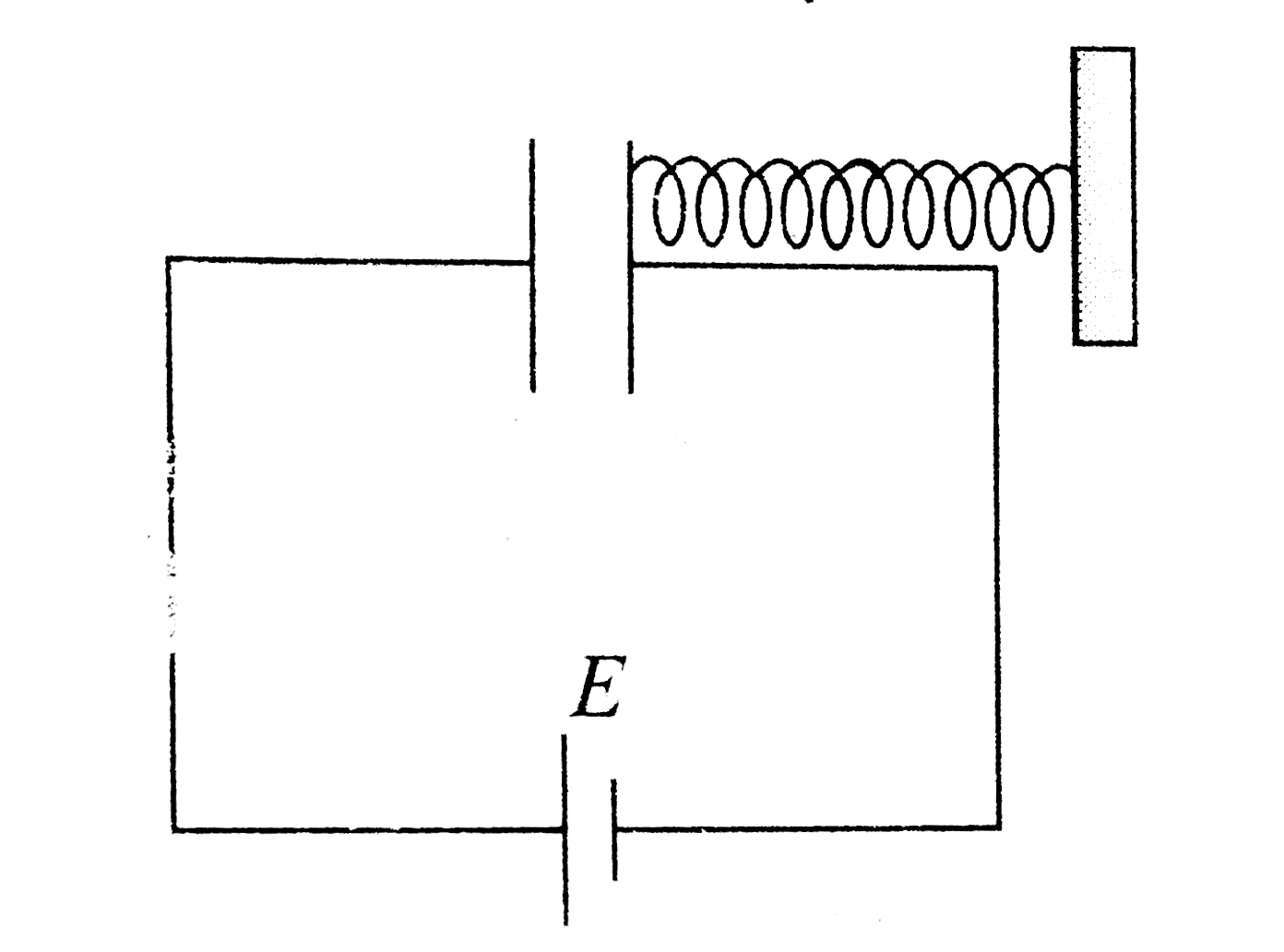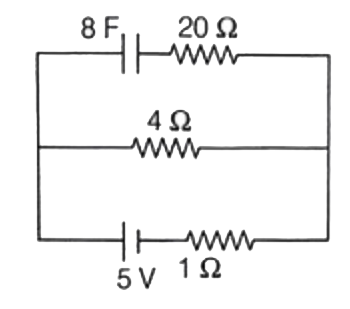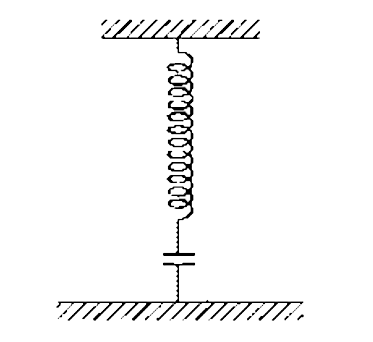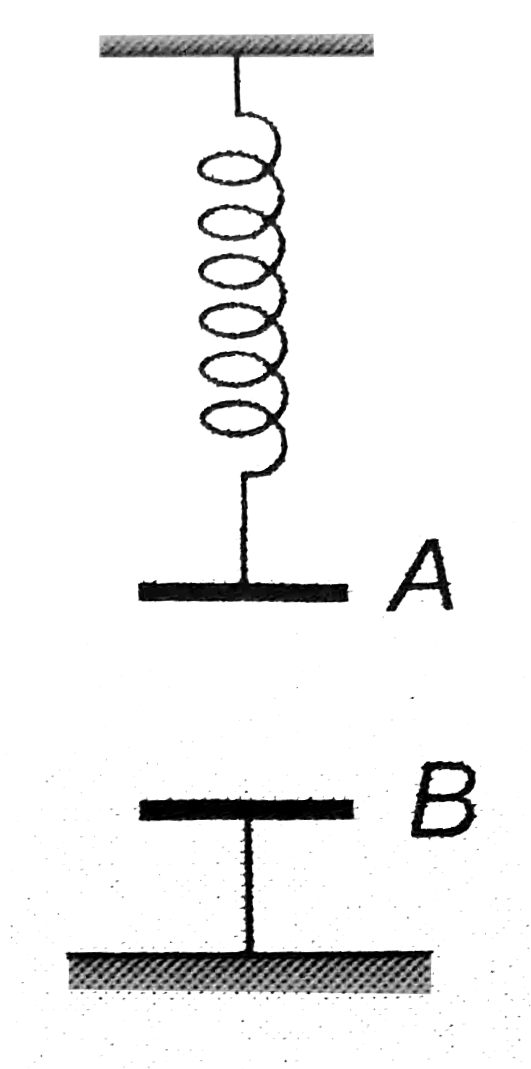One plate of a capacitor is connected to a spring as shown in figure. Area of both the plates is A. In steady state, separation between the plates is 0.8d (spring was unstretched and the distance between the plates was d, when the capacitor was uncharged). The force constant of the spring is approximately

The correct Answer is:A
Topper's Solved these Questions
- ELECTROSTATIC POTENTIAL AND CAPACITANCEBOOK - NARAYNACHAPTER - ELECTROSTATIC POTENTIAL AND CAPACITANCEEXERCISE - EXERCISE - 3 (PREVIOUS AIPMT QUESTIONS)
23 Videos
- ELECTROSTATIC POTENTIAL AND CAPACITANCEBOOK - NARAYNACHAPTER - ELECTROSTATIC POTENTIAL AND CAPACITANCEEXERCISE - EXERCISE - 4 (NCERT EXAMPLAR PROBLEMS)
6 Videos
- ELECTROSTATIC POTENTIAL AND CAPACITANCEBOOK - NARAYNACHAPTER - ELECTROSTATIC POTENTIAL AND CAPACITANCEEXERCISE - Exercise-2(C.W)
53 Videos
- ELECTROMAGNETIC WAVES BOOK - NARAYNACHAPTER - ELECTROMAGNETIC WAVES EXERCISE - EXERCISE -4
15 Videos
- ELECTROSTATICS AND GAUSS LAWBOOK - NARAYNACHAPTER - ELECTROSTATICS AND GAUSS LAWEXERCISE - Intergers type question
11 Videos
Similar Questions
One plate of a capacitor is fixed, and the other is connected to a spring as shown in. Area of both the plates is A In strady state (equilibrium), separation between the plates is 0.8d (spring was unstretched , and the distance between the plates was d when capacitor was uncharged). The force conntant of the spring is approximately.

View SolutionA capacitor of 8 F is connected as shown in the figure. At steady state Charge on the plates of the capacitor

View Solution
Knowledge Check
One plate of a capacitor is fixed, and the other is connected to a spring as shown in. Area of both the plates is A In strady state (equilibrium), separation between the plates is 0.8d (spring was unstretched , and the distance between the plates was d when capacitor was uncharged). The force conntant of the spring is approximately.
 A12532ε0AE2d3B2ε0AE2d3C6ε0E2Ad2Dε0AE32d3
A12532ε0AE2d3B2ε0AE2d3C6ε0E2Ad2Dε0AE32d3A capacitor of 8 F is connected as shown in the figure. At steady state Charge on the plates of the capacitor
 A32 CB40 CC0 CD80 C
A32 CB40 CC0 CD80 CIf the separation between the plates of a capacitor is 5 mm , then area of the plate of a 3 F parallel plate capacitor is
A4.259×109m2B1.964×109m2C12.81×109m2D1.694×109m2
If the separation between the plates of a capacitor is 5 mm , then area of the plate of a 3 F parallel plate capacitor is
View SolutionA parallel plate capacitor ils arrranged horizontally in a mechanical situation with the lower plate is fixed and the other connected with a perpendicular spring as shown in figure. The area of eachh plate is A and in equilibrium the distance between te plates is d0. WHen the capacitor is connected with a source of voltage V, a new equilibrium appears after some displacement in upper plate with the new distasnce between the plates d1. Given that mass of the upper plate is m

View SolutionA paallel plate capacitor with air as a dielectric is arranged horizontally. The lower plate is fixed and the other connected with a perpendicular spring. The area of each plate is A and mass of uppar plate is m. In the steady position, the distance between the plates is d0. When the capacitor is connected with a battery of emf V, a new equilibrium appears, with distance between the plate as d.
(a) find the spring constant k.
(b) what is the maximum voltage for a given k in which an equilibrium is possible?

View SolutionThe force between the plates of a parallel plate capacitor of capacitance C and distance of separation of the plates d with a potential difference V between the plates, is.
View SolutionThe capacitance of a capacitor depends on
(A) Charge on the plates
(B) the size of the plates
(C) the shape of the plates
(D) the separation between the plates
View Solution
